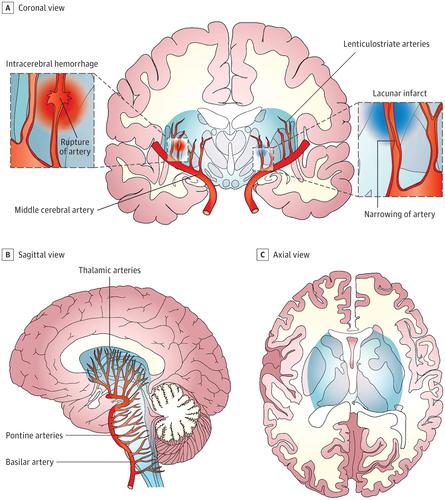JAMA Neurology ( IF 20.4 ) Pub Date : 2019-03-01 , DOI: 10.1001/jamaneurol.2018.4627
J David Spence 1

|
To the Editor There is an important element missing from the review of the pathogenesis of cerebral small vessel disease by Regenhardt et al1: the large gradient in blood pressure from the base of the brain to small vessels over the convexity. “True” lacunar infarctions due to hypertensive small vessel disease (lipohyalinosis and fibrinoid necrosis) occur at the base of the brain in a distribution known as the “vascular centrencephalon” (Figure).2 In that distribution, short small arteries with few branches transmit pressure from large arteries to small arterioles (this phenomenon was mentioned by Regenhardt et al1 in likening the kidney to the brain). So hypertensive lacunar infarctions and intracerebral hemorrhages are found in the distribution of the basal ganglia, internal capsule, thalamus, and brainstem.
中文翻译:

大脑中血压梯度的重要性:脑小血管疾病。
致编者Regenhardt等[ 1]回顾了脑小血管疾病的发病机理,其中缺少一个重要因素:从大脑底部到小凸起上方小血管的血压大梯度。由高血压小血管疾病(脂透明质酸和纤维蛋白样坏死)引起的“真”腔隙性脑梗死发生在大脑底部,分布称为“血管中脑”(图)。2在这种分布中,短小动脉,分支很少,将压力从大动脉传递到小小动脉(Regenhardt等[ 1]提到了这种现象。就像将肾脏比作大脑一样)。因此,在基底节,内囊,丘脑和脑干的分布中发现了高血压腔隙性脑梗塞和脑出血。

































 京公网安备 11010802027423号
京公网安备 11010802027423号